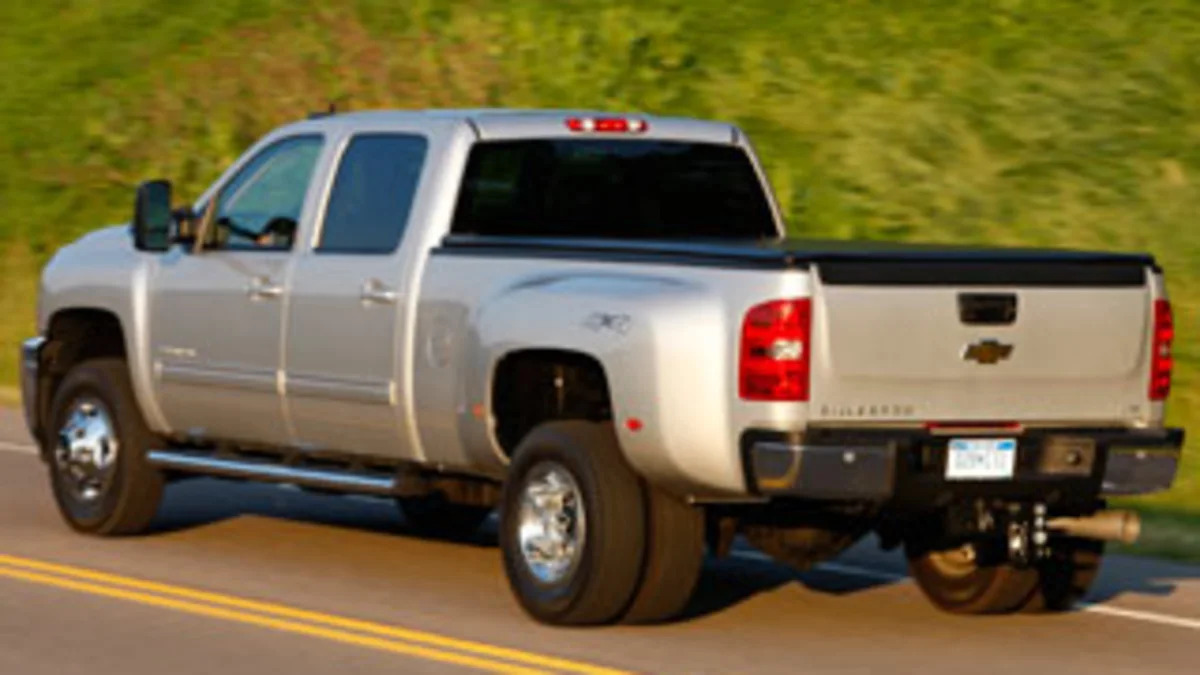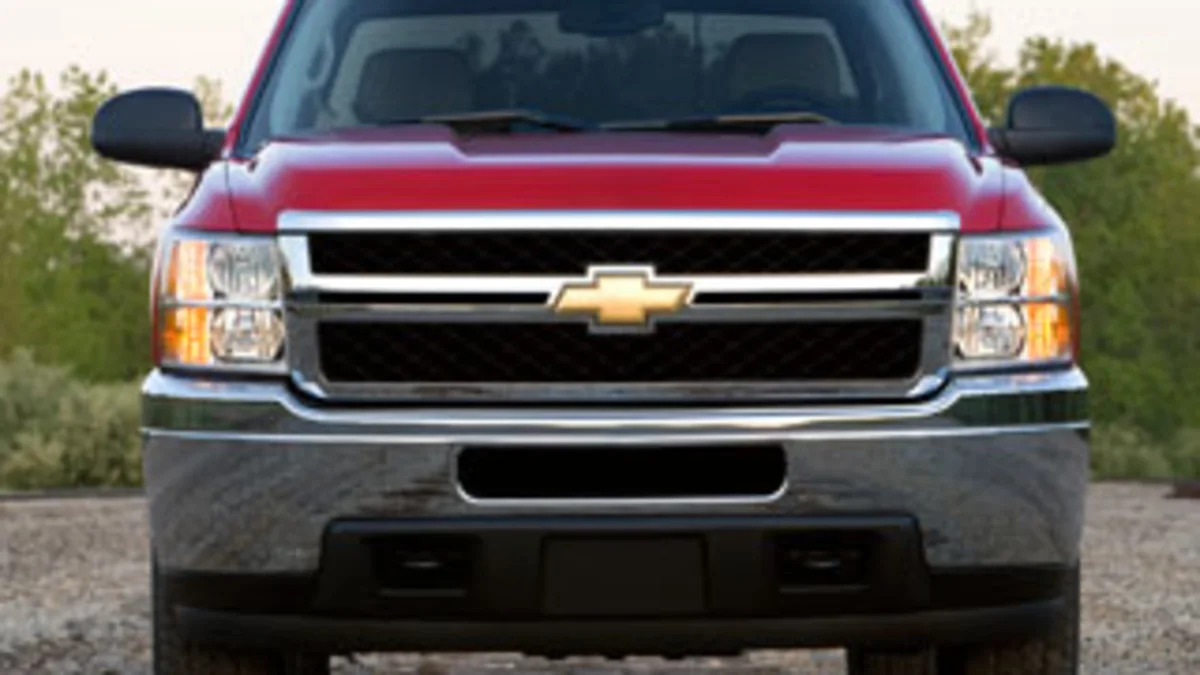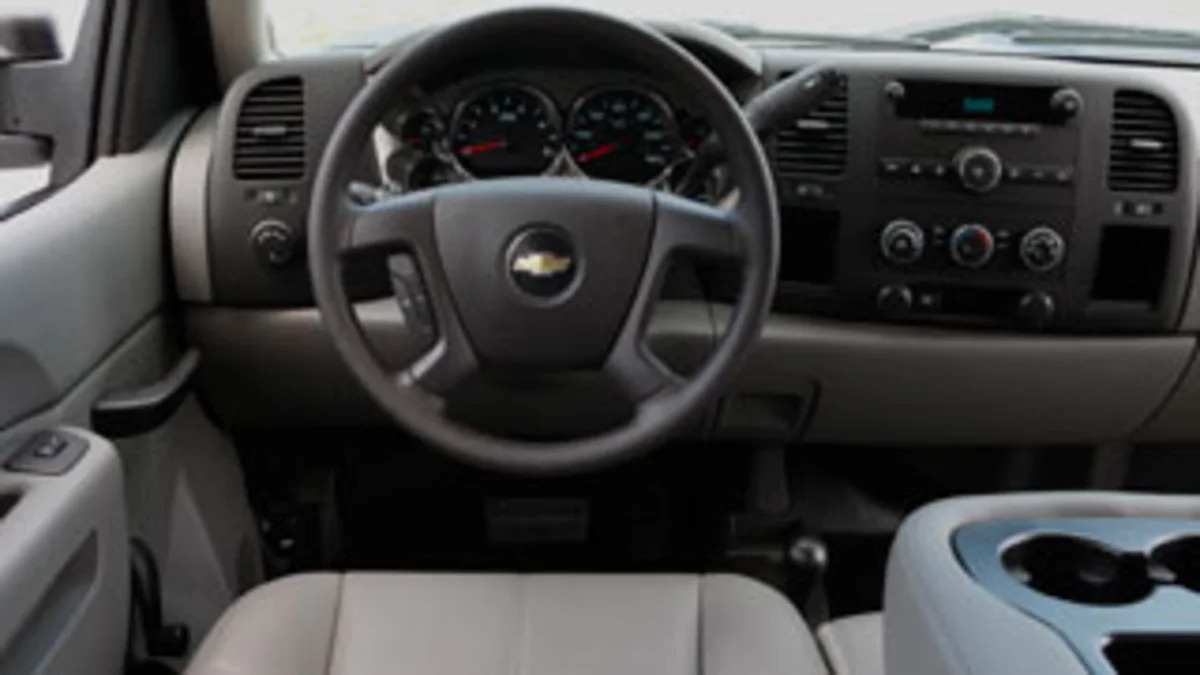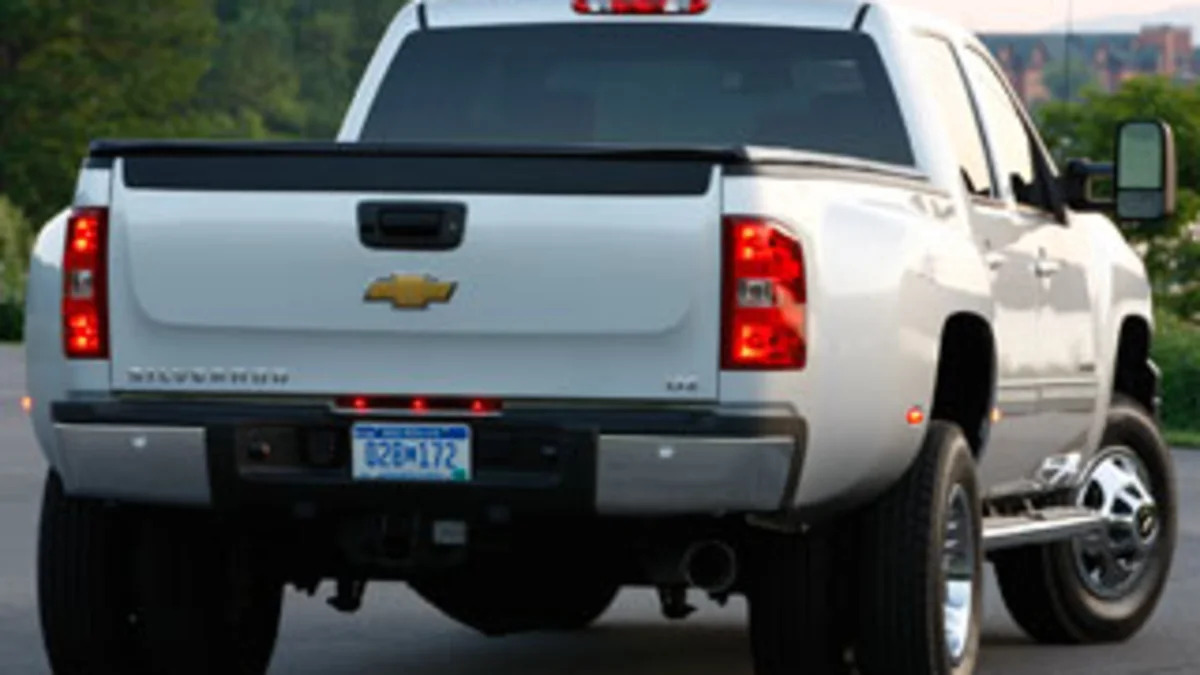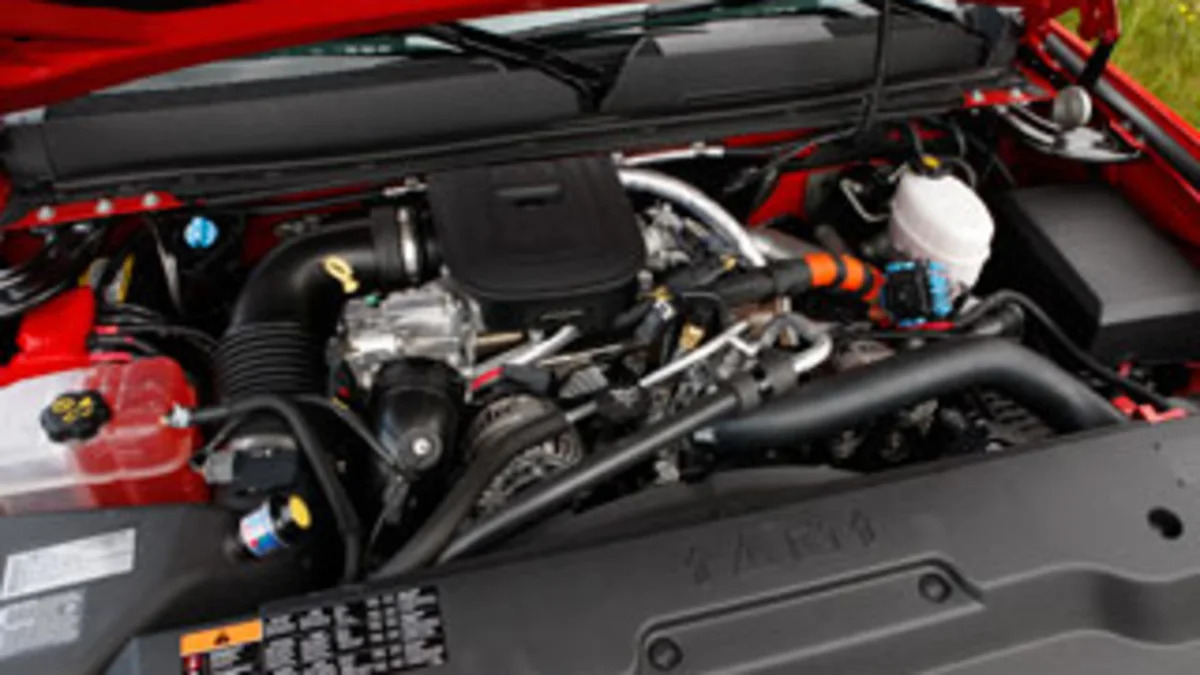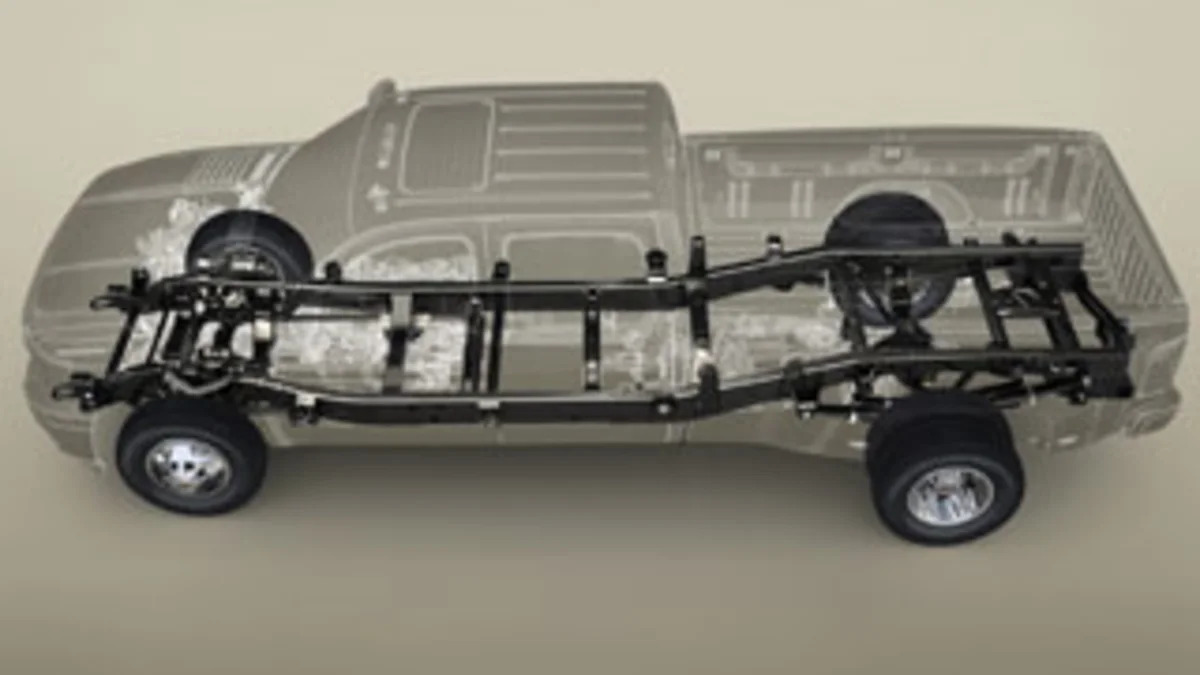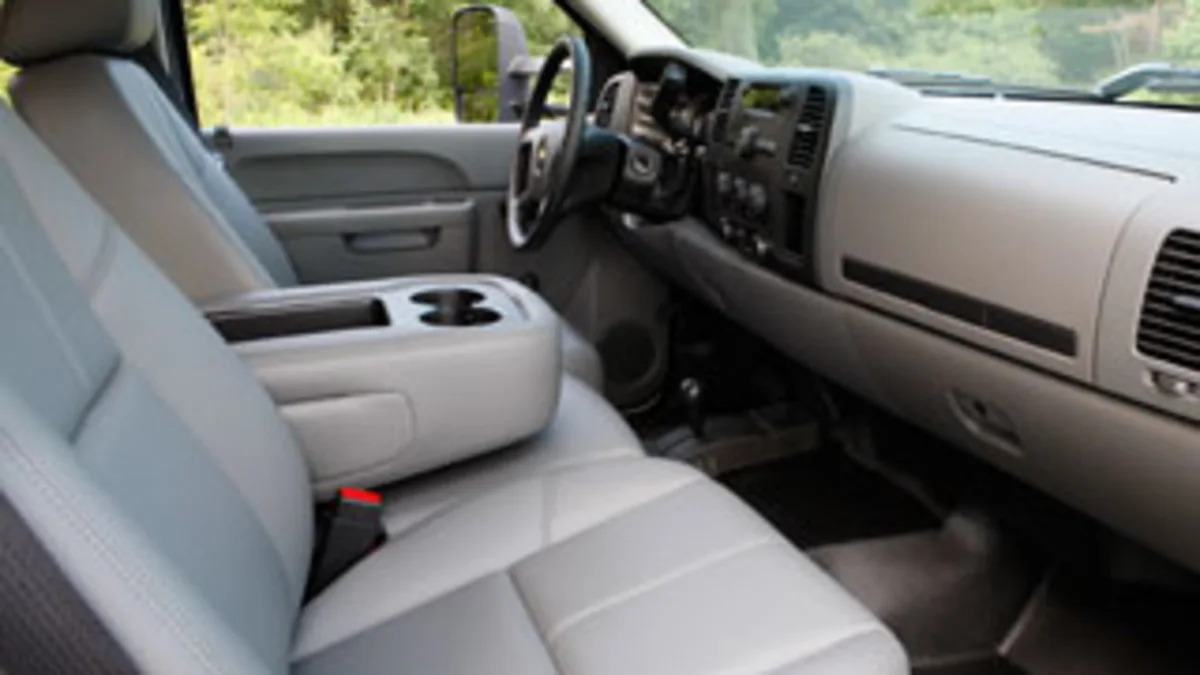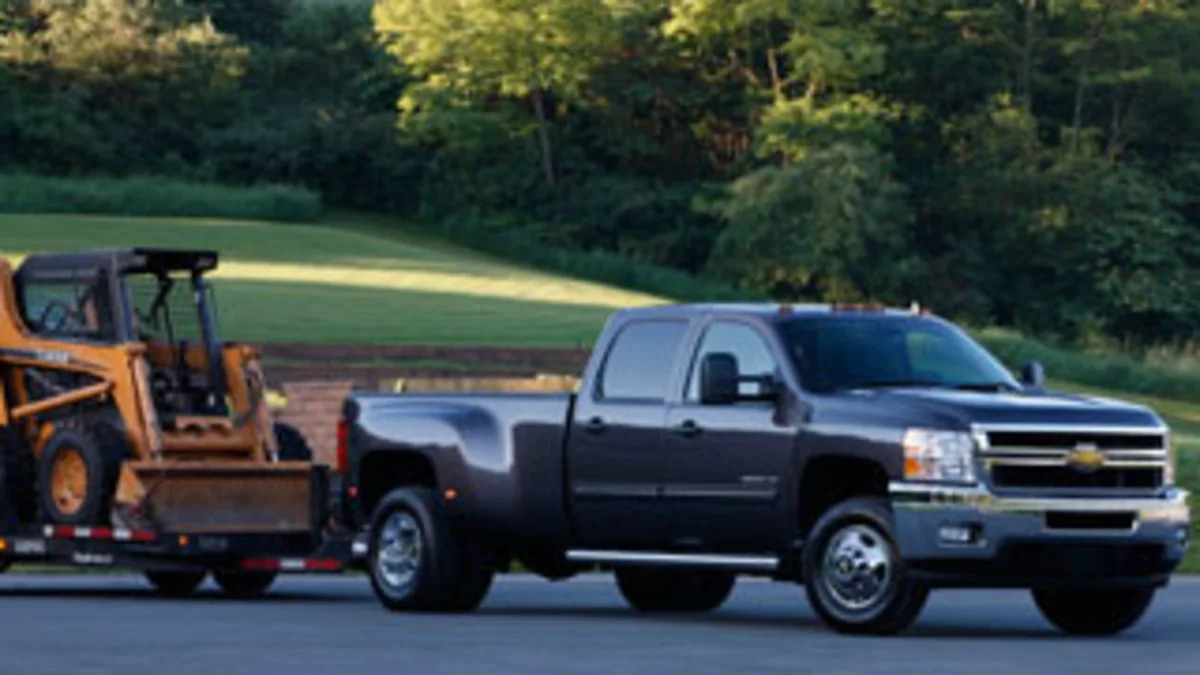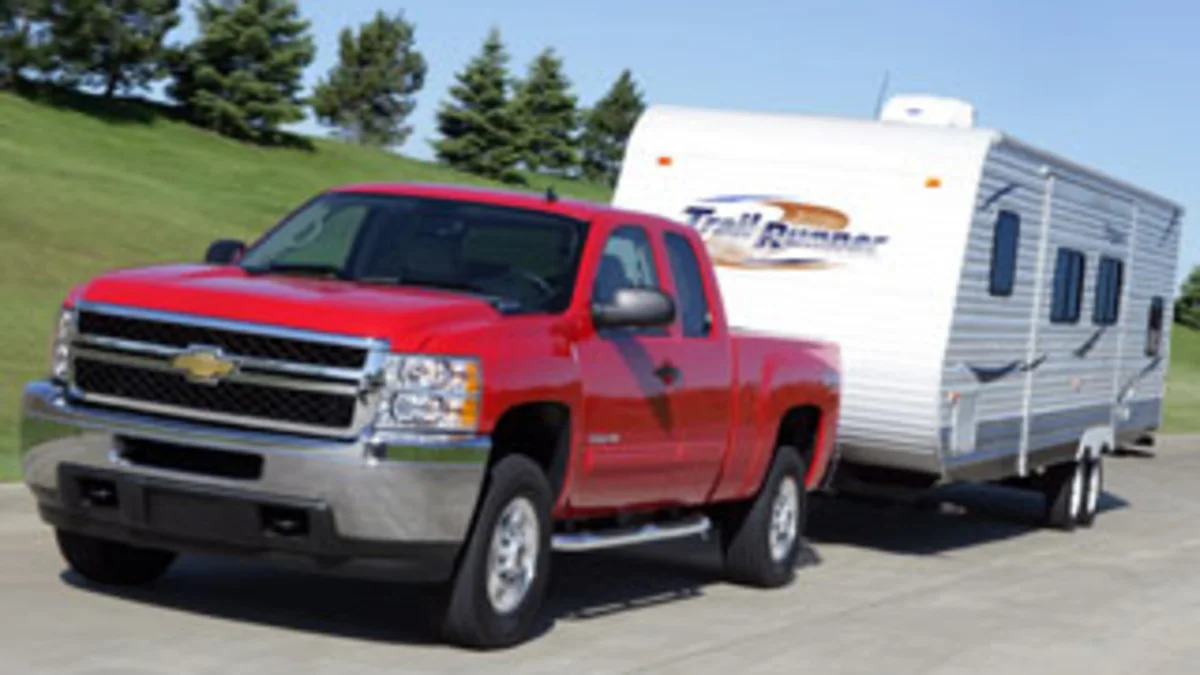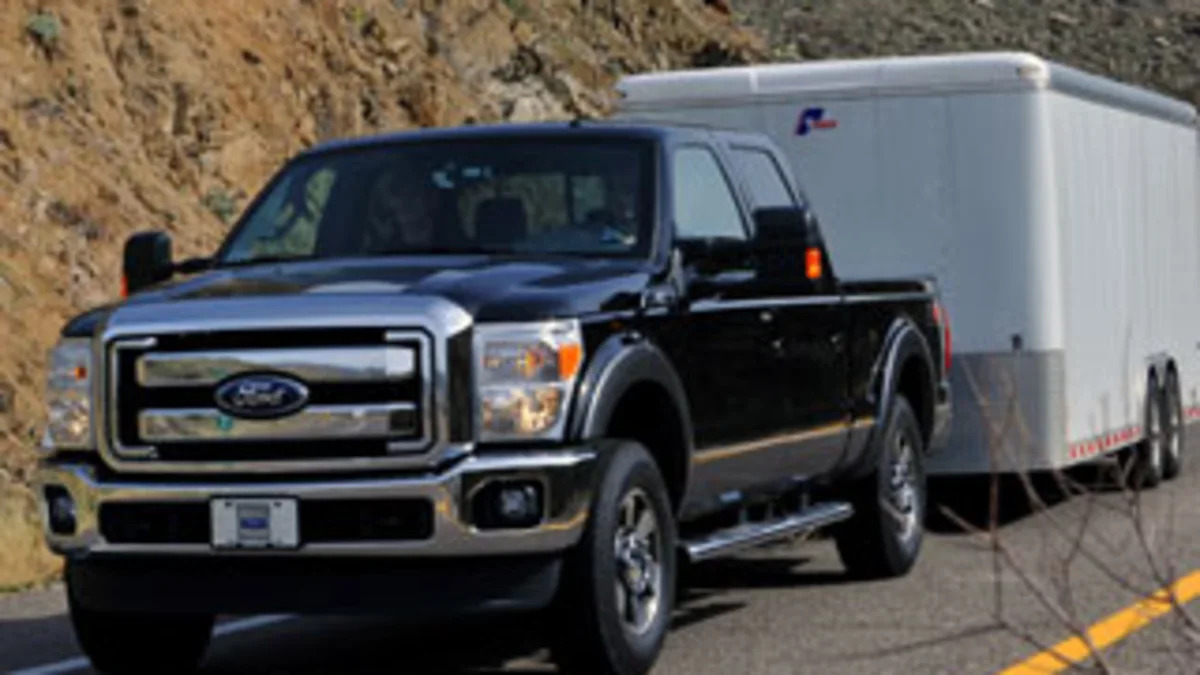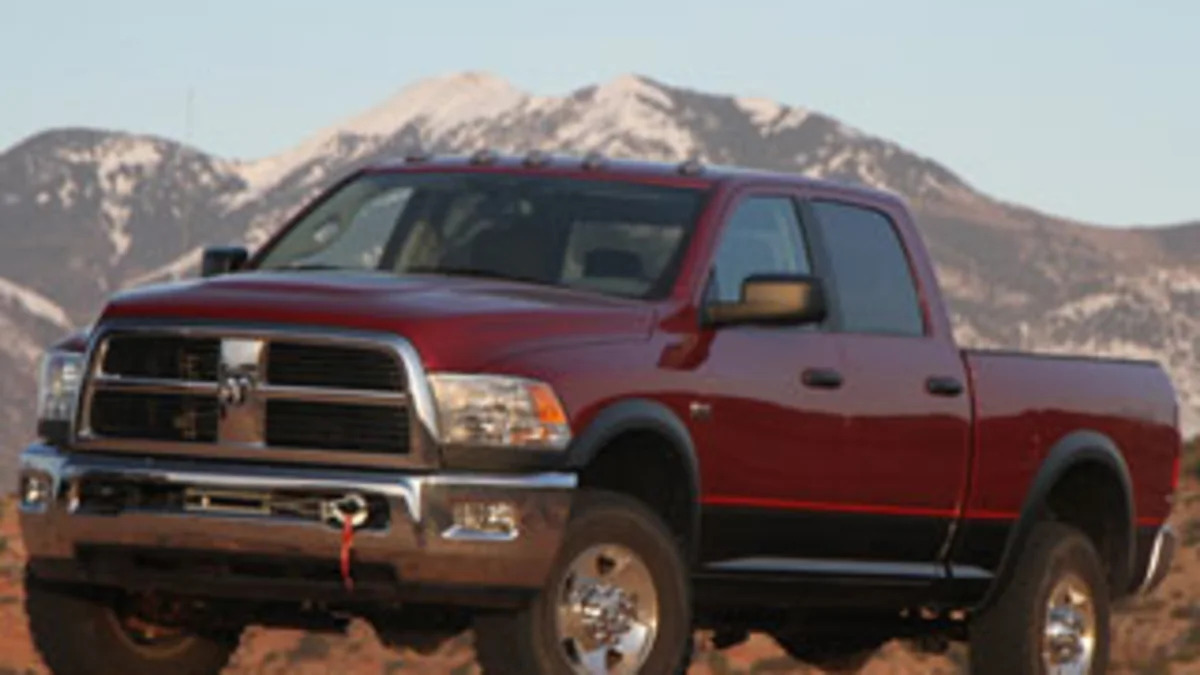Driven: 2011 Chevy Silverado Heavy-Duty - It's A Really Big Truck
Oct 17, 2010
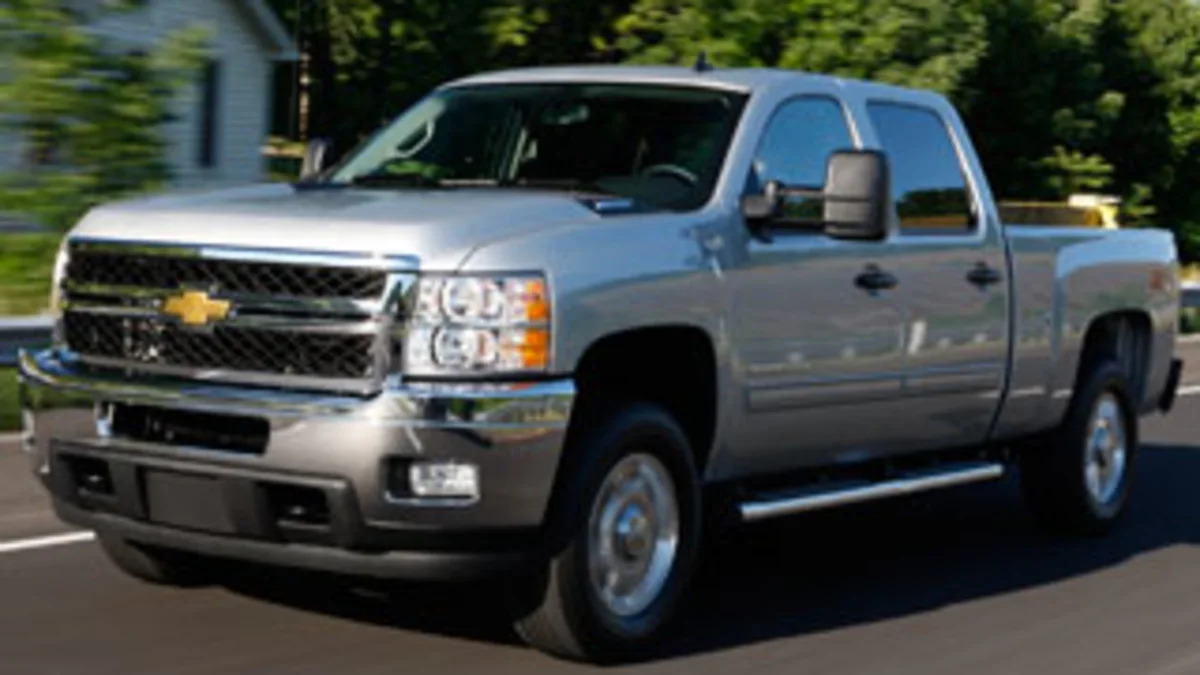
-

- Image Credit: GM
I wasn't sure what was making me sweat so much as I walked up to the driver's door of the 2011 Chevy Silverado HD. The heat, I told myself, was likely the culprit. After all, the mercury read 90 degrees and I was way out in the middle of a field in Frederick, Maryland. There wasn't an iced coffee in sight.
The real reason I was sweating: A full 10,000-pound Case Skid Steer Loader lay dead on a trailer behind my Chevy. It was the perfect little yellow metal boulder, just waiting to fall off the end or tumble over the side of the trailer on the long, steep tow I had in front of me. The road looked like a trucker's nightmare, with steep grades flanked by rocky outcroppings, winding roads through deer-infested forests, and cliffs that looked like Bob Ross paintings.
This is the sort of hauling that you and I will never do, even in our most barbaric dreams. But it is the sort of thing manufacturers dream up because they are as natural of a habitat for testing heavy-duty trucks as a racetrack is for a Ferrari.- Research the 2011 Chevrolet Silverado HD
- Chevrolet Silverado HD Photos & Information
- Chevrolet Silverado HD Best Deal
- Chevrolet Silverado HD Local Dealer Price Quote
-
- Image Credit: GM
If trucks are big business to domestic carmakers, heavy trucks are another item altogether. Not only do the big rigs represent significant profit margins (consider that the least expensive heavy-duty pickups start in the high twenties and go on up over $50,000 faster than you can say “beef jerky”), but they also mean bragging rights. As grown up as those Detroit execs look in their pinstripe suits, they are really just children at heart. Having the biggest, baddest, most powerful truck is one way to prove... well, something.
For 2011, Chevy is offering a broad lineup of HD pickups, with 10 2500HD models and eight single- and dual-rear-wheel 3500HD models. For my tow, I was driving the new 3500 HD LT Crew Cab “Dually,” featuring the new 6.6-Liter Duramax Diesel V-8.- Research the 2011 Chevrolet Silverado HD
- Chevrolet Silverado HD Photos & Information
- Chevrolet Silverado HD Best Deal
- Chevrolet Silverado HD Local Dealer Price Quote
-
- Image Credit: GM
Staring at the new Silverado HD I was glad I had my sunglasses. The sun bounced off yards of chrome on the truck's body and silver paint, which went some way toward distracting me from the fact that the 2011 Silverado is essentially a carryover from last year. Save a new raised hood, a shiny chrome front bumper with a larger air intake and bigger optional wheels, the rest of the truck retains the telltale Silverado HD characteristics of 2010.- Research the 2011 Chevrolet Silverado HD
- Chevrolet Silverado HD Photos & Information
- Chevrolet Silverado HD Best Deal
- Chevrolet Silverado HD Local Dealer Price Quote
-
- Image Credit: GM
Inside, too, the 2011 model is almost indiscernible from 2010, minus some new technology like the latest version of OnStar, mobile WiFi and USB connectivity. It's not the most comfortable place in the world, as the cloth seats, plasticky plastic and stereo seem pretty ho-hum, but this is understandable in a work truck. There is adequate space in the backseat, great visibility in all four directions, a clean and simple dashboard, and thoughtfully large temperature-control knobs to accommodate work or winter gloves.- Research the 2011 Chevrolet Silverado HD
- Chevrolet Silverado HD Photos & Information
- Chevrolet Silverado HD Best Deal
- Chevrolet Silverado HD Local Dealer Price Quote
-
- Image Credit: GM
All in all, the 2011 Silverado looks and feels good both inside and out. But while it was enjoyable for me to sit in the parking lot taking in the truck's impressive aesthetics, I was ready to get on the road and see what was below the surface. Plus, you know, it was 90 degrees and I needed that icy blast of air conditioning to keep me going.- Research the 2011 Chevrolet Silverado HD
- Chevrolet Silverado HD Photos & Information
- Chevrolet Silverado HD Best Deal
- Chevrolet Silverado HD Local Dealer Price Quote
-
- Image Credit: GM
For 2011, the Silverado HD has some significant upgrades that remain unseen to the casual onlooker. Among them is an optional Duramax 6.6L V-8 diesel engine, an all-new “smart” exhaust brake and an array of new control features including trailer sway control, trailer brake control and hill-start assist, all of which work as a means of trailer control and safety.
According to GM, the Duramax now leads the segment with 397 HP and 765 lb.-ft. of torque. That's not a misprint. Seven hundred sixty five pound feet. That's... well, that's a lot of twist. GM also claims that the engine reduces NOx emissions by at least 63 percent, as diesel engines continue to become a far cry from their smog-spewing ancestors.- Research the 2011 Chevrolet Silverado HD
- Chevrolet Silverado HD Photos & Information
- Chevrolet Silverado HD Best Deal
- Chevrolet Silverado HD Local Dealer Price Quote
-
- Image Credit: GM
The most important upgrade, however, is the all-new chassis. Comprised of 18 fully boxed, high-strength steel frame assemblies, the new chassis increases maximum conventional towing capacity and payload to 16,000 lbs and 6,635 lbs, respectively. The chassis is also designed to improve ride quality and provide optimal vehicle control for the driver.
Sixteen thousand pounds is a lot of weight to haul, but at the end of the day if the truck is unable to control it with relative ease, that number is essentially meaningless. I would not be towing quite that amount of weight of that along my hilly joyride, but I'd like to think that a 10,000-pound trailer and a 2,000-pound payload is more than adequate to obtain a good feel for how well the truck can perform.- Research the 2011 Chevrolet Silverado HD
- Chevrolet Silverado HD Photos & Information
- Chevrolet Silverado HD Best Deal
- Chevrolet Silverado HD Local Dealer Price Quote
-
- Image Credit: GM
The Silverado impresses before I even shift into drive, as there's a serious absence of engine noise. Though turning the key produces the distinctive roar of a diesel engine, it was muted to more of a purr inside the cabin. Even while revving the engine, the noise is still easy enough to talk over.
Shifting into drive, the truck's power gets the trailer moving with relative ease. Often in these big trucks with earth-pulling engines, the throttle response is more of a snap. The Silverado still has the ability to push you back into your seat, but the throttle response is nuanced enough that you're not spilling your coffee.- Research the 2011 Chevrolet Silverado HD
- Chevrolet Silverado HD Photos & Information
- Chevrolet Silverado HD Best Deal
- Chevrolet Silverado HD Local Dealer Price Quote
-
- Image Credit: GM
Pulling away, I felt the trailer and payload back there, but the engine gave not a groan. I had set out fully expecting a drive that demanded strict attention to keeping the hefty trailer between the yellow and white lines. But towing along the snaking road proved to be much easier than anticipated. Sharp curves were everywhere, but the effective trailer sway control system kept the trailer's wheels on the correct part of the asphalt, almost as if they were controlling themselves.
Going down the steep hills I had the opportunity to use the immensely effective exhaust brake. The Chevy engineers were very proud of the new “smart” exhaust brake on the Heavy Duties and rightfully so. This driver-selected feature uses the turbine control of the turbocharger along with engine compression to generate remarkably powerful backpressure, which works to slow the Silverado while traversing down steep grades. Applying the exhaust brake worked wonders in controlling the trailer while going down hills, saving the brakes some wear and tear.- Research the 2011 Chevrolet Silverado HD
- Chevrolet Silverado HD Photos & Information
- Chevrolet Silverado HD Best Deal
- Chevrolet Silverado HD Local Dealer Price Quote
-
- Image Credit: GM
At the few stop signs that sprinkled the route, the trailer came together in a very controlled way. Surprise red octagons were kept in check. At one such stop, inconveniently located on a very steep incline, the Silverado's hill start assist had the chance to prove itself. Bracing for a lurch backwards as I readied to turn onto another road I let my foot off the gas. The truck and trailer, however, remained steady as the hill start assist held everything in place with seeming ease.
All in all, the drive wasn't terribly long, but it was enough to make it obvious that when it comes to towing, the 2011 Silverado HD does the work. Though I never forgot I had a trailer behind me, I caught myself driving as if I didn't. It was as if my subconscious had ceded authority of controlling the trailer to the truck itself and left me to revel in just driving the thing.- Research the 2011 Chevrolet Silverado HD
- Chevrolet Silverado HD Photos & Information
- Chevrolet Silverado HD Best Deal
- Chevrolet Silverado HD Local Dealer Price Quote
-
- Image Credit: GM
While the 2011 Silverado HD is most certainly a thoroughly capable truck, it is not by any means cheap. At base, the HD will set you back about $27,956 plus a $995 destination charge. If you want to opt for the mean towing prowess of the 3500 HD LT Crew Cab DRW with the Duramax Diesel V-8 that I was driving, prepare to shovel out around $50,000.- Research the 2011 Chevrolet Silverado HD
- Chevrolet Silverado HD Photos & Information
- Chevrolet Silverado HD Best Deal
- Chevrolet Silverado HD Local Dealer Price Quote
-
- Image Credit: GM
The Chevy team was adamant about not disclosing fuel economy numbers, and heavy-duty pickups are exempt from EPA fuel economy testing. However, if GM's claim that the new Duramax has 11 percent better fuel economy we'd estimate it returning around 17 mpg combined. And with a new 36-gallon fuel tank, you certainly won't be stopping to refuel very often.- Research the 2011 Chevrolet Silverado HD
- Chevrolet Silverado HD Photos & Information
- Chevrolet Silverado HD Best Deal
- Chevrolet Silverado HD Local Dealer Price Quote
-
- Image Credit: Ford
The Silverado's main competition comes from the 2011 Ford Super Duty, which starts at $28,740. The Super Duty comes with two engine choices: The standard 6.2-liter, 385-hp V8, which produces 405 lb-ft of torque, and the 6.7-liter, 390-hp Power Stroke V8 turbo-diesel, which produces 735 lb-ft of torque. Ford's HD offering has a maximum payload of 6,520 pounds and a conventional towing capacity of up to 16,000 pounds, both of which are nearly equal to the 2011 Silverado's towing and payload capabilities.- Research the Ford Super Duty
- Ford Super Duty Photos & Information
- Ford Super Duty Best Deal
- Ford Super Duty Local Dealer Price Quote
-
- Image Credit: Chrysler
Chrysler also offers a heavy-duty version of its Dodge Ram, which starts at $27,545 for the 2500, and $35,120 for the 3500. The base engine for the 2500 is a 383-hp, 5.7-liter V8, while the 3500 comes with a 6.7-liter Cummins turbo-diesel inline-six, which produces 350 hp and 650 lb-ft of torque. The Ram's maximum payload specs come up short of the Silverado's at 5,150 lbs., but it has a massive conventional towing capacity of around 16,500 lbs.- Research the Dodge Ram HD
- Dodge Ram HD Photos & Information
- Dodge Ram HD Best Deal
- Dodge Ram HD Local Dealer Price Quote
-
- Image Credit: GM
But before you start scratching your head in earnest, puzzling over which heavy-duty truck to buy, think on this for a minute: You likely don't need a heavy-duty pickup. Sure, there are legitimate applications for these brutes -- lots of them -- and they tend to run towards commercial use. In other words, if you need a heavy-duty pickup, you know it.
If you're buying a truck as a daily driver and occasional tow vehicle, however, you'll be better served with a half-ton pickup. Towing capability for this class of truck has increased in recent years, while improvements to comfort and ride have been engineered in as well. A properly equipped Silverado 1500 can tow up to 10,700 pounds, and with a starting price of just over $20,000, you'll save quite a bit over a heavy-duty truck.
But of course, your toy won't be the biggest or the baddest.- Research the 2011 Chevrolet Silverado HD
- Chevrolet Silverado HD Photos & Information
- Chevrolet Silverado HD Best Deal
- Chevrolet Silverado HD Local Dealer Price Quote
